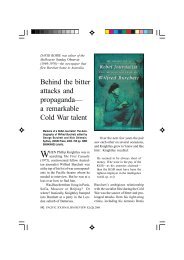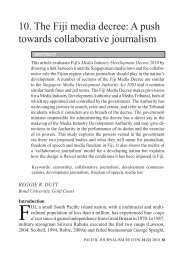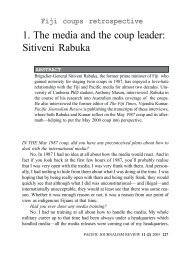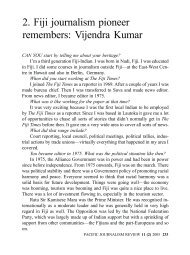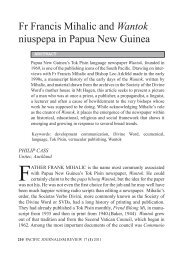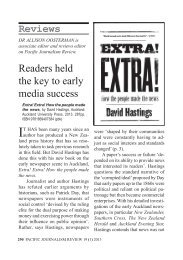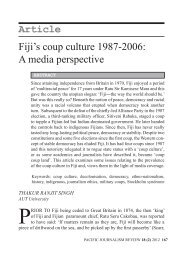1. A case study in ethical failure - Pacific Journalism Review
1. A case study in ethical failure - Pacific Journalism Review
1. A case study in ethical failure - Pacific Journalism Review
You also want an ePaper? Increase the reach of your titles
YUMPU automatically turns print PDFs into web optimized ePapers that Google loves.
MEDIA ETHICS AND ACCOUNTABILITY<br />
push<strong>in</strong>g an issue or have an <strong>in</strong>terest <strong>in</strong> actually keep<strong>in</strong>g it hidden, it can easily<br />
fall off the news agenda. This appears to have occurred <strong>in</strong> the <strong>case</strong> of report<strong>in</strong>g<br />
of deaths <strong>in</strong> custody. The wholesale <strong>failure</strong>, for <strong>in</strong>stance, to follow up on<br />
critical f<strong>in</strong>d<strong>in</strong>gs of coroners <strong>in</strong>vestigat<strong>in</strong>g deaths may be partly due to shr<strong>in</strong>k<strong>in</strong>g<br />
editorial resources <strong>in</strong> newspapers and broadcast media. Web publish<strong>in</strong>g<br />
has meant there is a lot more easily accessible <strong>in</strong>formation that should enable<br />
journalists to follow-up reports with few resources. Governments’ use of public<br />
relations professionals to block questions has <strong>in</strong>creased over the last 14 years<br />
and is discourag<strong>in</strong>g critical report<strong>in</strong>g. In this context, journalism educators<br />
need to constantly develop their students’ practical skills <strong>in</strong> fast research for<br />
multi-source and critical report<strong>in</strong>g.<br />
The importance for journalists and journalism educators of discuss<strong>in</strong>g<br />
the issue with Aborig<strong>in</strong>al organisations cannot be overemphasised. Without<br />
their tireless push<strong>in</strong>g, there would have been no Royal Commission. Several<br />
under-funded community Aborig<strong>in</strong>al organisations have cont<strong>in</strong>ued to push<br />
the issue onto the agenda. If they did not exist, there would have been even<br />
fewer stories s<strong>in</strong>ce 1992. These organisations have also published a large<br />
amount of material on this issue on the <strong>in</strong>ternet, nearly all of which has been<br />
ignored by the media. They have played a significant role <strong>in</strong> enabl<strong>in</strong>g journalist<br />
and the public to access <strong>in</strong>formation about deaths <strong>in</strong> custody.<br />
Follow<strong>in</strong>g the Royal Commission, there were a number of conferences<br />
between Aborig<strong>in</strong>al organisations and journalists to discuss the report<strong>in</strong>g of<br />
<strong>in</strong>digenous issues (Hartley, 1994). It is time to re<strong>in</strong>vigorate this process and<br />
use that as a way of highlight<strong>in</strong>g and remedy<strong>in</strong>g media silence.<br />
Protocols for <strong>in</strong>digenous report<strong>in</strong>g and other codes and pr<strong>in</strong>ciples do play<br />
a role <strong>in</strong> guid<strong>in</strong>g journalists, and <strong>in</strong>deed may have contributed to the high<br />
number of Aborig<strong>in</strong>al sources used <strong>in</strong> deaths <strong>in</strong> custody stories s<strong>in</strong>ce the early<br />
1990s. On the other hand, such codes are not sufficient when <strong>in</strong> comes to<br />
address<strong>in</strong>g gaps <strong>in</strong> coverage. Indeed if not applied <strong>in</strong> practice, they can become<br />
mere tokens.<br />
Hundreds of students <strong>study</strong> journalism at Australian universities each<br />
year. One strategy that journalists work<strong>in</strong>g as educators <strong>in</strong> those universities<br />
might consider is how they might activate this very large report<strong>in</strong>g resource<br />
to address the <strong>failure</strong> of Australian media to adequately cover the issue of<br />
deaths <strong>in</strong> custody and other <strong>case</strong>s of media accountability <strong>failure</strong>.<br />
This would not only provide a way of l<strong>in</strong>k<strong>in</strong>g research with journalism<br />
38 PACIFIC JOURNALISM REVIEW 11 (2) 2005



